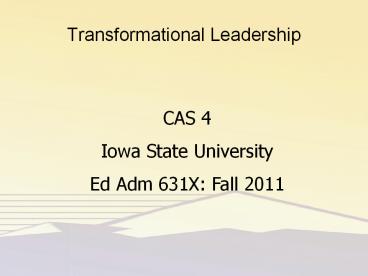Transformational Leadership - PowerPoint PPT Presentation
1 / 31
Title:
Transformational Leadership
Description:
Title: The Transformational Leadership Program Author: Mary Morris Last modified by: mberninghaus Created Date: 1/4/2002 8:09:17 PM Document presentation format – PowerPoint PPT presentation
Number of Views:411
Avg rating:3.0/5.0
Title: Transformational Leadership
1
Transformational Leadership
CAS 4 Iowa State University Ed Adm 631X Fall
2011
2
Overview
- Review and adjust your leadership agenda
- Increase understanding of alignment and coherency
- Identify members of your guiding coalition
- Dilemma of Practice
3
The Transformational Map
4
The Transformational Map
5
The Transformational Map
6
The Transformational Map
7
The Transformational Map
8
Elements of the Leadership Agenda
- Mission
- Case for change
- Preferred future
- Major strategies
- Indicators and milestones
9
STRATEGIES
- (Strategic areas of work more specific
strategies) - Strategies answer the question,
- What major approaches must I take to achieve
transformational change?
10
50 85 of executives who led change in their
organizations were dissatisfied with the results.
11
Random Acts of Improvement
12
It is possible to get lots of change and none of
the results.
13
Initiatives with direction
14
Doing the Right Things
15
Deciding the right things to do, taking action,
and studying the effects is the learning.
16
Leadership Actions
- How Leaders Allocate Their Time
17
Presenting Your Agenda
- Case for Change
- Preferred Future
- Strategic Areas
- Assigned Triads for Feedback and Coaching
18
Gaining Agreement Commitment
- Continuously articulate the vision
- Recruit a guiding coalition
- Enroll strategic partners
- Develop resources
19
Elements of the Leadership Agenda
- Mission
- Case for change
- Preferred future
- Major strategies
- Indicators and milestones
20
Gaining Agreement and Commitment Key Issues
- Define Strategies
- Build Consensus
- Address Resistance
- Identify the coalition and their work
- Align employees and other stakeholders
21
Define the Strategies
- Strategies are
- our approaches to achieving our vision
- our approaches to our work
- our approaches to getting what we want
- Search for strategies that have a proven track
record or theoretical underpinnings that imply
success.
22
Build Consensus
- Leaders assess the degree of consensus
- Conduct continuous dialogue
- Identify individuals in your circle of agreement
23
Address Resistance
- Identify the competing dynamics
- Recognize resistive behaviors
- Respect that resistance exists it is natural
and predictable - Manage resistance accordingly
24
Identify the Coalition and Their Work
- Who are they?
- Small group (6-8)
- Not advisory group (although they may start as
this) - Serves as work group or planning group
25
The Coalition and Their Work (cont.)
- What does the guiding coalition do?
- Support the leadership agenda
- Gain agreement and commitment of stakeholders
- Identify and facilitate learning
- Embed the change
- Develop their own leadership capacities
26
The Coalition and Their Work (cont.)
- How do you identify the guiding coalition?
- Passionate
- Expertise
- Power, status and influence
- Willing to lead
- Committed to the long haul
- Able to obtain resources- money/people/time
- Mix of managers and leaders
27
The Coalition and Their Work (cont.)
- How do you recruit and support the guiding
coalition? - Recruit
- Seduce them
- They are the busiest and brightest
- Must be something in it for them
- Support
- Planning time, coaching, learning with others
- Held accountable, recognized, compensated
28
Alignment and Coherency
- System coherency requires alignment (goals,
actions, beliefs, and measurements) which is
dependent upon. . . - Continuous dialogue
- Communication and learning
- Negotiated personal and team objectives
- Incentives and rewards
29
Key Question
- What would it take to re-design your job so
everything you do aligns with your leadership
agenda?
30
Your Mission Statement. . .
- is a one sentence description of the
transformational change you are leading - reveals the essence of your leadership work
- is succinct and powerful
- grabs attention
- keeps you centered
31
Mission Statement
- My leadership mission is to . . .
- The mission I am on is to . . .































